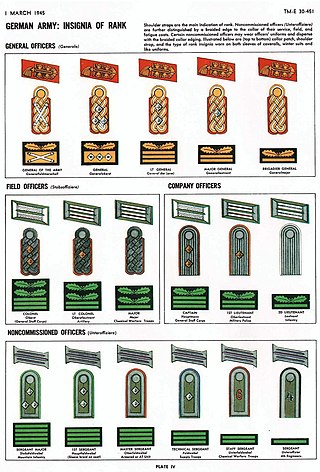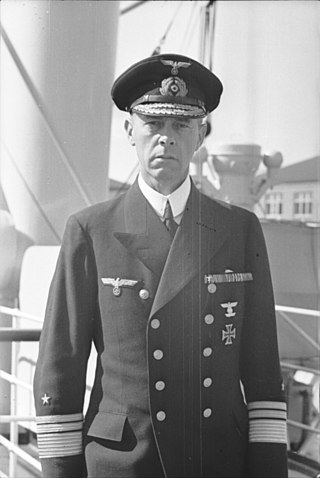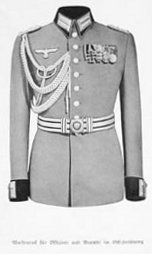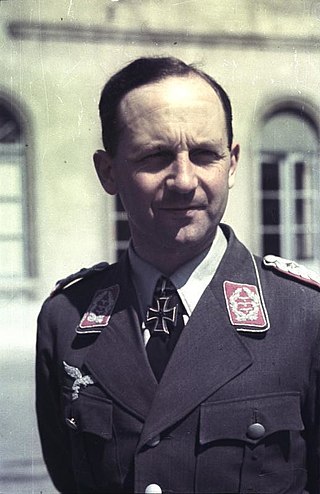
Gorget patches are an insignia in the form of paired patches of cloth or metal on the collar of a uniform (gorget), used in the military and civil service in some countries. Collar tabs sign the military rank, the rank of civil service, the military unit, the office (department) or the branch of the armed forces and the arm of service.

In the German military, Waffenfarbe is a visual method that the armed forces use to distinguish between different corps or troop functions in its armed services. The Waffenfarbe itself can take the form of the color of the collar patch, of the piping (embellishment) around the shoulder boards or shoulder marks, or—for enlisted ranks—of the piping around the collar and the garrison cap (Schiffchen).

The following is a general overview of the Heer main uniforms, used by the German Army prior to and during World War II.

Gymnastyorka was a Russian military smock comprising a pullover-style garment with a standing collar having double button closure. Additionally, one or two upper chest pockets, with or without flaps, may have been worn. It had provision for shoulder boards and sometimes reinforced elbows and cuffs. The Tsarist version had the standing collar while the M35 version had a stand-and-fall collar which was replaced with the standing collar in the M43 version. The Soviet Military M35 version usually had hidden buttons. A double breasted version (kitel) for officers of all ranks existed during the Tsarist period.
Oberstarzt (OTA) is a military rank in German speaking armed forces. It denotes a medical staff officer surgeon or medical staff officer dentist and is comparable to Colonel (de: Oberst) or Captain (naval) (de: Kapitän zur See) NATO-Rangcode OF5 in anglophone armed forces.

The Heer as the German army and part of the Wehrmacht inherited its uniforms and rank structure from the Reichsheer of the Weimar Republic (1921–1935). There were few alterations and adjustments made as the army grew from a limited peacetime defense force of 100,000 men to a war-fighting force of several million men.
The rank insignia of the federal armed forces of the Federal Republic of Germany indicate rank and branch of service in the German Army, German Air Force, or the German Navy.

The Kriegsmarine was the navy of Nazi Germany prior to and during World War II. Kriegsmarine uniform design followed that of the preexisting Reichsmarine, itself based on that of the First World War Kaiserliche Marine. Kriegsmarine styles of uniform and insignia had many features in common with those of other European navies, all derived from the British Royal Navy of the 19th century, such as officers' frock coats, sleeve braid, and the "sailor suit" uniform for enlisted personnel and petty officers.

The Luftwaffe was the air force of Nazi Germany prior to and during World War II. Luftwaffe styles of uniform and rank insignia had many unique features between 1935 and 1945. By Hitler's decision on February 26, 1935, the Luftwaffe was to be officially the third branch of the Wehrmacht as of March 1, 1935. The new Luftwaffe was faced with the problem of uniforms, as they wanted a uniform distinct from those of the other two branches of the Wehrmacht and also wanted a clear differentiation in dress of military and civilian flyers.

Waffenrock was originally a medieval German term for an outer garment, worn by knights over their armor.
Corps colours, or Troop-function colours were worn in the Waffen-SS from 1938 until 1945 in order to distinguish between various branches of service, units, and functions. The corps colours were part of the pipings, gorget patches, and shoulder boards. The colour scheme was similar to the corps colours of the German Army from 1935 to 1945. The colours appeared mainly on the piping around the shoulder boards showing a soldier's rank.

Corps colours, or Troop-function colours, were worn by the National People's Army of the German Democratic Republic from 1956 to 1990.
Oberstabsarzt is a military rank in German speaking armed force. It describes a medical staff officer surgeon or medical staff officer dentist comparable to major or lieutenant commander NATO-Rangcode OF3 in anglophone armed forces.
This article deals with the rank insignia of the Austro-Hungarian Army, as worn by the Austro-Hungarian Army after the reorganisation in 1867 until 1918.
Oberfeldarzt is a military rank in German speaking armed forces. It denotes a medical staff officer surgeon or medical staff officer dentist and is comparable in rank to lieutenant colonel or (naval) commander NATO-Rangcode OF4 in anglophone armed forces.
Stabsarzt, in English Staff Surgeon, is a military commissioned officer rank in German speaking armed forces. In the German Bundeswehr and the former Wehrmacht and Reichswehr, it describes a qualified or licensed surgeon or dentist who practises military medicine, with a rank equal to captain in the army and the air force or lieutenant in the navy. In the Austrian and Swiss armies, the rank is Hauptmann.
Assitenzarzt was a military rank in the Austrian-Hungary Common Army until 1918 and in German Reichswehr and Wehrmacht until 1945.

Corps colours, or troop-function colours were worn in the German Luftwaffe from 1935 until 1945, in order to distinguish between several branches, special services, corps, rank groups, and appointments of the ministerial area, the general staff, and the Oberkommando der Wehrmacht (OKW). The corps colours were part of the uniform piping, gorget patches, shoulder straps, arabesque and lampasse ornaments of general and flag officers. They were also part of heraldic flags, colours, standards, and guidons.
Between 1943 and 1955, the ranks and insignia of the Soviet Armed Forces were characterised by a number of changes, including the reintroduction of rank insignia badges and the adoption of a number of higher ranks.

Waffenfarbe(n) or Egalisierungsfarbe(n) are colors that communicate the rank and arm of service for members of the police force or the Federal Army of the Republic of Austria (de: Bundesheer der Republik Österreich). They are also referred to as Kragenspiegel (English: collar patches or gorget patches).





















